HTIRC E-NEWSLETTER – October 2011
Volume 4 Issue 2
Articles in this issue:
- HTIRC Welcomes Two New Scientists
- Passing the Torch
- Integral First Steps to Emerald Ash Borer Resistance and Conservation of Pumpkin Ash (Fraxinus profunda)
- Manipulation of Stomatal Density in Green Ash (Fraxinus pennsylvanica) Alters Biomass Partitioning in Extreme Cases
- Hawaiian Wood Bowls Highlight the Tropical Hardwood Tree Improvement and Regeneration Center and the Society of American Foresters
- Thousand Cankers Disease Found in Additional Eastern US Locations in 2011
- American Chestnut Trees Return to the Hoosier National Forest
Welcome to this issue of the Hardwood Tree Improvement and Regeneration Center E-newsletter. The HTIRC is committed to enhancing the productivity and quality of Central Hardwood Region trees and forests for the economic and environmental benefits they provide. Scientists at the HTIRC are using conventional tree improvement breeding as well as molecular and genetic technologies to improve the wood quality, growth characteristics, and insect and disease resistance of trees like black walnut, black cherry, red and white oaks, butternut and American chestnut.
Research in tissue culture, tree nursery practices, tree plantation establishment and management, and Central Hardwoods silvicultural systems is aimed at increasing the regeneration success rate for high quality hardwood trees and forests. Some interesting and unusual research areas include examining the potential for propagating trees with “figured” wood: birds-eye maple or curly walnut; and breeding trees that will be an economical source of bio-fuels.
Twice per year, we will attempt to provide interesting and useful information on Central Hardwood trees and forests, as well as sources for additional information and assistance.
Please pass this newsletter along to others who may enjoy or benefit from the information provided. If you would like a closer look at the HTIRC, please visit our web site at: http://www.htirc.org
HTIRC Welcomes Two New Scientists
The Hardwood Tree Improvement and Regeneration Center at Purdue University enthusiastically welcomes two new scientists to our ranks, Dr. Songlin Fei and Shaneka Lawson.
Dr. Songlin Fei comes to Purdue University and the Hardwood Tree Improvement and Regeneration Center from the University of Kentucky, where he was an Assistant Professor of Forest Biometrics and Spatial Analysis. He holds a Ph.D. from the Pennsylvania State University. His research interests include ecosystem dynamics and modeling, invasive species modeling and surveillance, and biometrics and spatial analysis.
Shaneka S. Lawson, currently completing her Ph.D. at the Department of Forestry and Natural Resources, Purdue University with Dr. Paula Pijut, will assume her new duties as a Research Plant Physiologist on October 10, 2011. She will be employed as a US Forest Service scientist within HTIRC. In addition to other roles within the HTIRC mission, she will study the various environmentally-induced parameters that differentiate tropical hardwood populations that drive tropical hardwood genetic improvement.

Dr. Shaneka Lawson and Dr. Songlin Fei
Passing the Torch
Almost everyone has something from their past, some unfinished business, that weighs on their minds.
For Sam Grober, it was a tree, one nearly half a century back in his past; the only record of it was in his head. He had become a successful businessman, but at heart he was a scientist. The loss of that tree had nagged at him since the end of World War II.
Grober, working on a doctorate at the University of Maryland, received federal funding in the 1930s to study trees that could double as erosion control around farm fields and provide value as timber. The work led him to a type of poplar that had a unique, curly pattern to its grain, making it valuable for veneer.
Grober wrote a dissertation on the find, received his degree and then was drafted into service in the Pacific theatre of the war.
While in the U.S. Army, Grober’s forestry knowledge was put to use. He developed a system to streamline logging and milling on an island in the South Pacific that created lumber needed in the war effort. He later worked for Gen. Douglas MacArthur during the Allied occupation of Japan, where he reorganized the Japanese logging and lumber industry, transferring its control from the emperor to commercial enterprises.
Dream on Hold
When the war ended, Grober headed back to Maryland to pick up his work, only to find that the plot of test trees he had planted had been plowed under and his research materials lost in a fire. For the next several decades, that’s where it stood.
Grober used his eye for spotting high-quality wood to land log-buying jobs that sent him around the world searching for mahogany, teak and other premium hardwoods. “In Ghana and the Gold Coast, he would go in and choose the trees, the natives would cut them down and they would be floated down rivers to sawmills,” says David Grober, Sam’s son. “He was quite good at it.”
In the ensuing decades, Grober married, had two children, settled down in Evanston, Ill., and, by all accounts, lived a full and happy life. But there was always this unfinished business in Maryland.
“He thought about that tree his whole life. He always talked about it,” says M. Patricia Grober, Sam’s widow. “It was on his mind for at least 50 years.”
Where He Left Off
In the early 1980s, Grober found a way to resurrect his dream. He returned to Maryland and took a few cuttings from what he hoped was the offspring of one of his original trees home. Back in Evanston, he planted one in his front yard and hoped he’d found the right tree.
“It became a pet project of his,” David Grober says. “He wanted to prove that he was right about it. He was very much into promoting the health of the forest industry, and he always thought this would be a great crop with a great value to the industry.”
Over the next 20 years he started courting scientists to take an interest. Grober made the rounds, starting in the Pacific Northwest, a natural place to find scientists working in forestry. He would be disappointed, however. “He didn’t find a whole lot of interest from anyone in taking this on as a project,” David Grober says.
The problem, it seemed, is that poplar has often been a nuisance in hardwood areas. While poplar is technically a hardwood, it’s actually quite soft and is used mainly for paper and pulp products. Convincing scientists that poplar would be a valuable hardwood species became an uphill battle.
Then one day about eight years ago, Grober came to Purdue to make his pitch. He was sent to the new guy—Rick Meilan.
“Sam was in his 80s when I met him,” Meilan remembers. “I was just taken by his enthusiasm and knowledge, and I was a new faculty member looking for research projects.” Grober had found his scientist.
Meilan Signs On
“I thought it would be fascinating to find the genetic mechanism that causes the curly wood grain. We could engineer other trees to adopt this characteristic and add value to hardwood trees grown here in Indiana,” Meilan says.
When Grober’s tree reached the proper size, he and Meilan crossed their fingers, cut it down and took it to a mill to have it sliced into veneer. The waiting paid off as the first sheets showed the figured wood they’d hoped to find. The prized veneer resides in Meilan’s lab.
Years of research led to a patent on Grober’s figured poplar and an understanding of those genetic mechanisms. They’ve also planted hundreds of clones from the tree, which has and will continue to be used for further research.
“Poplar is becoming more important as a research species and has the potential to address issues in several areas,” Meilan says. He’s pushing for more plantations across the state to prove the value of poplars for veneer, fiber for paper and dimensional lumber, and as an energy crop. He believes the portions not used for veneer could be burned or possibly turned into a next-generation biofuel.
Over the years, Grober funded Meilan’s research, including a graduate-student position. “This kind of work would never be funded by the federal government,” Meilan says. “Sam knew that if he was going to see this work pursued, he was going to have to bankroll it.”
For Grober, it was worth it. Not only had Meilan taken on the work that he’d had to stop in the 1930s, he’d become a friend.
David Grober remembers watching his father standing near Meilan as the first sheets of veneer landed in his hands from the tree he’d planted in the yard all those years ago. “My dad was just beaming from ear to ear,” David Grober says. “It was just such a great experience for him.
“He was always curious about whether his conjectures were correct,” says David Grober about his father. “In a way, I think this was something that he had to do.”
While it’s common for people to dwell on unfinished business, Grober, with Meilan’s help, turned unfinished business into the fulfillment of a dream and saw to it that his work would survive long after he was gone.
Sam Grober died in February 2009. The work he started more than 70 years ago lives on through Rick Meilan.
Reprinted with permission from the Purdue Agricultures Magazine, Summer 2011
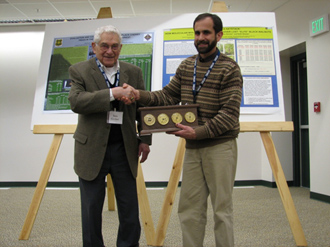
Sam Grober and Rick Meilan
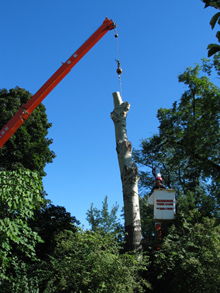
The Grober poplar being lifted out of Sam Grober’s yard in Evanston, IL
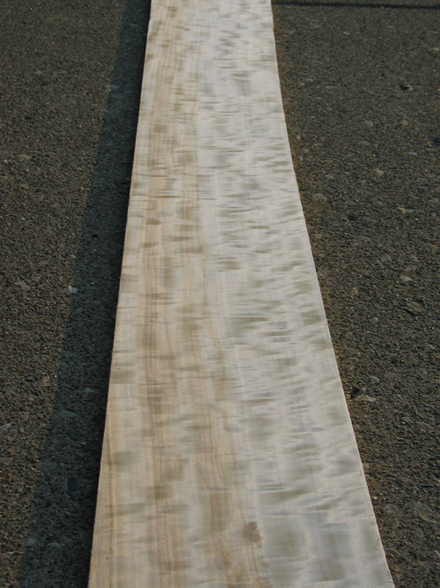
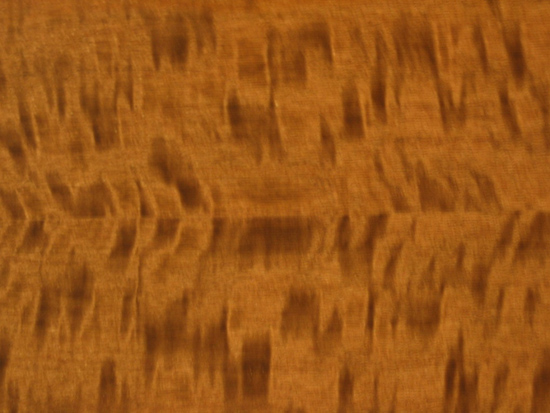
Raw and stained examples of the figured wood from the Grober poplar
Integral First Steps to Emerald Ash Borer Resistance and Conservation of Pumpkin Ash (Fraxinus profunda)
Pumpkin ash (Fraxinus profunda) is a key species in many Eastern North American wetland ecosystems. Its name is derived from the swollen or buttressed trunk base found on mature trees that is a result of the deprivation of oxygen soil environment in which it is grows. Seeds from pumpkin ash, much larger than many other ash species, are an invaluable source of nourishment for a variety of waterfowl, while leaves and shoots provide shelter and sustenance for many species of mammals. Pumpkin ash is a large, fast-growing tree reaching 120 ft at maturity. It has a disconnected native range being primarily found only in wetlands, swamps, coastal floodplains, and river bottoms of the Eastern United States. Similar to white (F. americana) and green (F. pennsylvanica) ash the wood of pumpkin ash is highly valued. Traditionally it has been used for high valued lumber, and stock for implement and tool handles.
Pumpkin ash like other indigenous ash species is at serious risk of native extinction by the actions of the emerald ash borer (EAB) (Agrilus planipennis). The EAB causes tree mortality as developing larvae feed directly under the bark preventing the movement of nutrients through the trees’ vascular network. This interruption effectively girdles the tree causing branch dieback and eventually death of the infested tree. Like most non-native introduced pests or pathogens there is little resistance to this pest in our native ash populations. As such, EAB has led to the death of millions of North American ash trees as it spreads through the native range of ash species from its epicenter of introduction in Michigan.
The narrow and limited range of pumpkin ash increases the risk of removal from its natural environment. It is listed as endangered or threatened in a number of states. As EAB spreads through the pumpkin ash native range (Fig. 1), both through human (transport of logs or firewood) and natural dispersal it is becoming increasingly imperative to address the long-term survival of ash. One powerful tool to preserve and maintain this species is in vitro tissue culture. Tissue culture is a process by which plants are grown in small sterile vessels often on a gelatinous medium allowing factors that control plant growth to be strictly regulated such as mineral nutrition and plant hormones. Tissue culture techniques allow for a rapid build-up of superior plant material through sterile vegetative micro-cuttings “Micropropagation” or through relying on the innate ability of plants to regenerate and develop new organs, i.e. roots or shoots. These newly formed plantlets can then be acclimatized to ambient growing conditions and will continue to develop normally.
In vitro tissue culture protocols can often be challenging to establish, especially with hardwood trees. Every species behaves differently under in vitro conditions and the protocol must be tailored for each desired species. Besides a means for quickly propagating plant material, regeneration protocols also provide a basis for genetic modification of desirable traits. This technology will allow genes to be added to the ash genome, which will impart resistance to the EAB. However, for this approach to work, a successful and reliable in vitro regeneration system must first be established.
Previous research has been conducted to develop these protocols for other North American ash such as white, green, and black ash (F. nigra), but no research has been conducted with pumpkin ash. The goal of our research was to establish a regeneration protocol for pumpkin ash that could be used for conservation and future genetic modification. We were able to accomplish this objective by beginning with sterile hypocotyl seed sections and manipulating plant growth regulator levels (cytokinins and auxins) by testing different concentrations to recover adventitious shoots (Fig. 2). The hypocotyl is the portion of the seed between the elongating radicle (root) and cotyledons (seed leaves). Next through further manipulation of auxins and cytokinins newly grown shoots were induced to develop roots (Fig. 3). Finally, the newly generated plantlets were slowly weaned from the high humidity of the tissue culture environment to ambient growing conditions, where once repotted into larger pots quickly continued normal growth and development (Fig. 4). Plants must be slowly conditioned from an in vitro environment or else a rapid change would cause the plant to desiccate and die.
This study provides the groundwork for all future research on in vitro propagation of pumpkin ash as well as providing an effective means of genetic modification for EAB resistance. We will use this protocol to introduce a gene known to impart EAB resistance into pumpkin ash helping to conserve this valuable species.
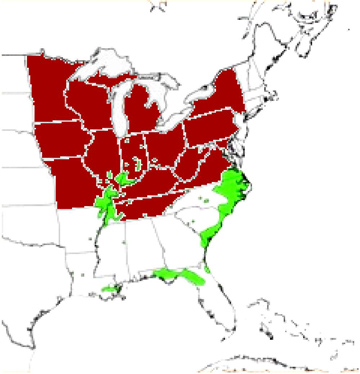
Figure 1. Native range of pumpkin ash (Green) (Fraxiunus profunda) (USDA Forest Service),
and EAB infestation as July 2011 (Red)
http://www.emeraldashborer.info/
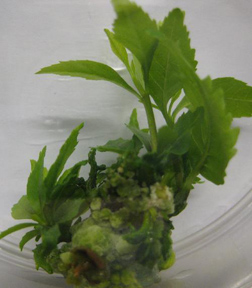
Figure 2. Hypocotyl derived adventitious shoot formation of pumpkin ash (Fraxinus profunda). Testing various concentrations of plant growth regulators allowed us to find an optimum range.
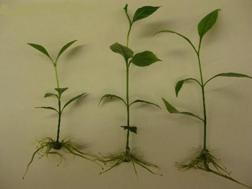
Figure 3. Adventitious root formed on in vitro growth microshoots. These plantlets will then be acclimatized, potted in sterile soil (Autoclaved) and moved to the greenhouse for continued growth and development.

Figure 4. Pumpkin ash regenerated from hypocotyls growing normally in the greenhouse.
Manipulation of Stomatal Density in Green Ash (Fraxinus pennsylvanica) Alters Biomass Partitioning in Extreme Cases
There are greater than 60 ash species in the family Oleaceae with green ash (Fraxinuspennsylvanica) attaining 60-80 ft. in size. Ash trees are valued as important timber resources as well as for ornamental uses. The prevalence of diseases and insect pests have limited the ability of green ash trees to extend beyond the current range. Green ash has one of the most expansive ranges of any native tree in North America and the immediate threats to its continued survival have encouraged a greater number of researchers to concentrate more efforts on improvement of ash species. Green ash trees are a robust drought-tolerant species able to grow in a wide variety of soil types although optimal growth is achieved when grown in moist, fertile soils. An exceptionally important species for its wood, genetic improvements in green ash that do not entail a decrease in aboveground biomass growth and increase environmental tolerance levels will likely be the most useful for hardwood aficionados and researchers interested in the preservation of the species. Many attempts have been made to engineer higher quality fine hardwood tree species. This article highlights an attempt to further improve the water-use efficiency (WUE) of green ash by manipulation of stomatal density and to scrutinize its ability to survive the extended drought periods predicted to occur as a result of a changing environmental climate.
Stomata are composed of a pair of guard cells with a pore between them (Fig. 1). Stomata are found in land plants and permit intake of carbon dioxide and exit of water. The maintenance of properly functioning stomata is imperative for plant survival in stressful environmental conditions and has recently been the focus of numerous studies. Plants with stomatal densities that have been decreased by genetic manipulation are able to limit moisture loss through transpiration and are often able to obtain sufficient CO2 intake to ensure proper growth. Gene expression levels that dramatically decrease stomatal densities severely limit CO2 uptake and result in decreased growth and productivity. In extreme cases diminished viability and plant death result from limited stomatal densities.
In the Pijut Lab at Purdue University, the overexpression of a poplar stomatal density gene in green ash led to an increase in water-use efficiency. This increase was determined by analyzing CO2 intake and water exit through leaf stomata. The objective is to allow for maximum CO2 influx while decreasing water efflux without interfering with biomass accumulation and normal tree growth. However, at the highest expression levels, increased expression of the poplar stomatal density gene resulted in interrupted or decreased growth. Although not seen in the majority of plant lines, the most severe effects in plants that expressed extremely high levels of the gene were stunted or severely delayed aboveground growth, and to a lesser degree fewer, smaller leaves (Fig. 2). These physiological responses are often found in desert species and are typical of plants that have adjusted to water-limited conditions and have improved drought-tolerance capabilities.
Biomass or resource partitioning is a mechanism used by plants in every environment to maximize growth and productivity in both optimal and sub-optimal conditions. Using semi-quantitative reverse transcriptase polymerase chain reaction (RT-PCR), a technique used to look at gene expression level, it was determined that expression levels of the poplar stomatal density gene were highest in trees with stunted growth. Trees expressing a lower level of the poplar gene were unaltered in aboveground biomass allocations, however belowground biomass was redistributed. A visual comparison of root growth indicated that those trees with modest levels of poplar gene expression often exhibited a distinctive increase in overall root biomass when compared to non-transformed ash (Fig. 3, 4). The main advantage of a more compact root system is that water resources within a smaller area are thoroughly exploited before water can infiltrate deeper layers. The disadvantage of a compact root system is that the rooting depth and soil moisture available to the plant is diminished. Under these circumstances, soil type and water infiltration rates become extremely important.
Transgenic green ash expressing the highest poplar gene levels demonstrated longer, less fibrous root systems able to reach deeper soil moisture deposits. The natural ability of green ash to survive in a number of soil types would be facilitated in transgenic ash expressing modest levels of the gene as roots remain fibrous, but were much sturdier and thicker. These results indicated that, while able to endure longer periods of limited water availability, our green ash trees expressing the highest gene levels were at a disadvantage compared to control plants and transgenics expressing moderate levels of the poplar gene. Trees with a fibrous root system were able to take advantage of small pools of moisture closer to the surface while transgenic ash expressing higher levels of the gene had longer, much less fibrous root systems, thus were less likely to fully utilize temporary moisture deposits closer to the surface. Under experimental conditions where plants were kept at field capacity, or in an environment at the greatest moisture level possible without runoff occurring. Non-transgenic green ash were able to endure short periods of flooding while it appeared that, in addition to a shorter stature, the highest expression level transgenics were also unable to survive the highly saturated conditions. Transgenics exposed to an extremely wet environment responded with the production of overly thickened roots with a seemingly scaly exterior in addition to severely limited aboveground biomass (Fig. 5). Collectively, these data showed that green ash drought tolerance capabilities may be improved with a gene from another model species; however harmful side effects were potential risks of genetic manipulation.
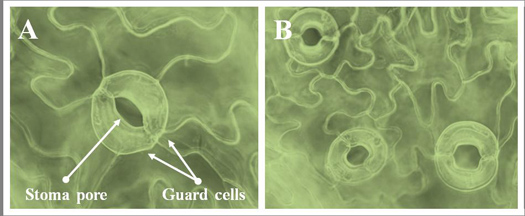
Figure 1. Examples of stomata. (A) A single stoma or stomate (B) compared to multiple stomata (Right) in green ash
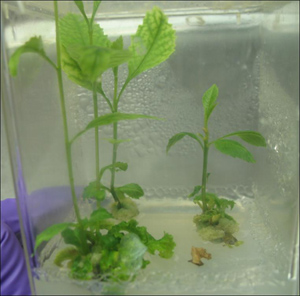
Figure 2. Comparison of untransformed (Left) and transgenic (Right) green ash. Clear differences in shoot height were apparent at a young age as untransformed plants were nearly twice as tall as the transgenic
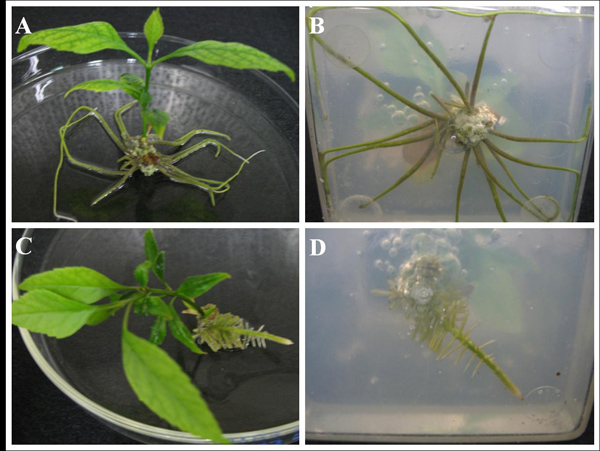
Figure 3. Variation in lateral root growth of size-matched and age-matched green ash transgenics expressing high and moderate levels of the poplar gene. (A) High expression level plantlet lacked lateral roots. (B) Close up view of transgenic without lateral roots, but exhibiting increased root lengths. (C) Transgenic expressing a moderate level of the transgene demonstrates a significantly increased number of lateral roots, and (D) a close up view indicating an increase in lateral root formation and decreased overall root length.
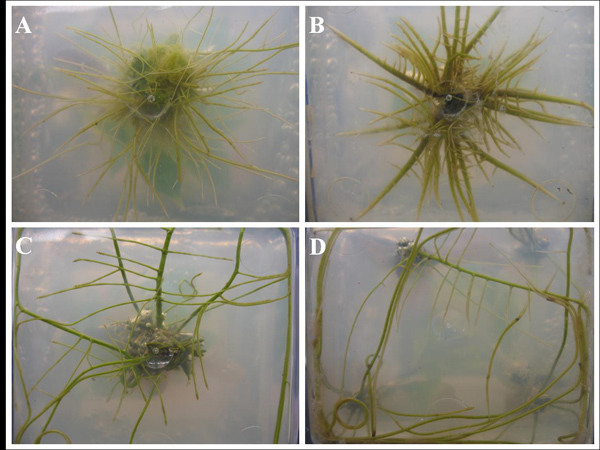
Figure 4. Root development phenotypes, or observable traits, in age-matched transgenic green ash. (A) Lack of lateral root branches in a control or non-transformed line. (B) Moderate expression transgenic line with shorter, thickened roots, and substantial lateral branches. (C) Greatly elevated transgene expression line. (D) Group of age-matched high-expression transgenic lines with identical root phenotypes, indicating that the root development phenotype can be attributed to genetic differences and not coincidence.

Figure 5. Aberrant resource allocation in transgenic green ash exposed to field capacity moisture conditions.
(A) Formation of large, thick, segmented roots in a line expressing the highest poplar gene expression levels.
(B) Close up of root segments. (C) Close up of root meristems.
Hawaiian Wood Bowls Highlight the Tropical Hardwood Tree Improvement and Regeneration Center and the Society of American Foresters
Bob Masuda is working to educate foresters about conservation of the native trees of Hawai’i by providing several beautiful Koa bowls to be raffled at the Society of American Foresters National Convention in Honolulu this November 2nd thru 4th. In addition, an exceptional segmented wood bowl, made of four important Hawaiian woods, Koa, Kou, Milo & Kamani, will be used as a silent auction item. This magnificent bowl would be valued at between $1500 and $2000 at an art gallery. These bowls, made by Hawaiian wood turners, will be displayed at the Hardwood Tree Improvement and Regeneration Center booth in the convention exhibit hall at the Hilton Hawaiian Village Resort, and proceeds will go to the Society of American Foresters Science Fund to advance forestry research.
The HTIRC is cooperating with many partners in Hawaii and elsewhere to launch a Tropical Hardwood Tree Improvement and Regeneration Center to enhance the regeneration, conservation, and management of important hardwoods of the Hawaiian Islands. The raffle and auction of these beautiful hand-turned bowls will be a great way to introduce this effort to the professional forester community.

Hand-turned segmented wood bowl made from Hawaiian woods Koa, Kou, Milo & Kamani
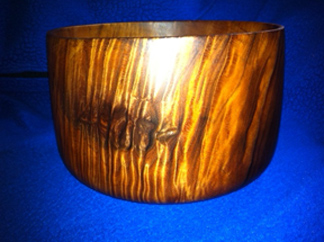
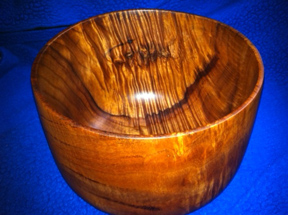
Highly figured Koa wood hand-turned bowls
Thousand Cankers Disease Found in Additional Eastern US Locations in 2011
Thousand Cankers Disease has been found in Bucks County, Pennsylvania and Chesterfield and Henrico Counties of Virginia and the city of Richmond, Virginia. Six Counties are now part of the infested areas of Eastern Tennessee. Thousand Cankers Disease (TCD) threatens black walnut (Juglans nigra) and other members of the walnut family with decline and death caused by the walnut twig beetle (Pityophthorus juglandis) boring and subsequent infection by a Geosmithia fungus carried by the beetles. The twig beetles bore into the branches of black walnut, often by the tens of thousands, and create egg galleries within the bark. The Geosmithia fungus is carried into the bark of the tree by the beetle and forms small cankers. As the number of beetles and cankers infesting a tree increases, they may ultimately girdle branches resulting in the collapse of the foliage in the crown and finally tree death. The build-up of beetles and cankers may take several years, but once wilting of foliage or branch mortality is noted, the tree is usually dead within two or three years.
Thousand Cankers Disease was originally identified in the Western United States on black walnut planted as street trees. Many communities in the western US have lost most of their black walnut to TCD. The walnut twig beetle is native to the Southwestern United States and is a minor pest on damaged or shaded branches of Arizona walnut (Juglans major), but does not cause tree mortality in this species. When the beetle jumped to black walnut, which is not a native tree in the Western US, it found a host with little natural resistance to invasion by the beetle and infection by the canker-forming fungus. TCD was found in the native range of black walnut in Knox County, Tennessee in the summer of 2010 when dead and dying street trees in the area of Knoxville were examined.
It is almost certain that the spread of TCD into the Eastern US is a direct result of human movement of infected walnut materials from the infested areas in the West. It is now vital to slow the spread of this disease to provide time to explore potential control techniques and to limit potentially devastating economic and environmental impacts related to loss of the black walnut resource, historically the most valuable tree in the eastern hardwood forest. Many states have enacted quarantines regulating the movement of black walnut materials from TCD infested areas, so check for quarantine information before moving walnut materials. Some products that are generally exempt from quarantine are nuts, nut meats, kiln-dried lumber that is 100% free of bark, and manufactured walnut items that are kiln-dried and bark-free. The twig beetle and fungus can both live in the bark of logs, wood-turning blanks, bark-on lumber, and firewood for extended periods after a tree is cut, so movement of this material presents a high risk of introducing TCD to new locations and may be in violation of state quarantines, depending on the source of the material.
To help landowners, resource professionals, and forest products industries access current information on TCD, the HTIRC in cooperation with USDA APHIS and USDA Forest Service is developing a national Thousand Cankers Disease information website. The site is currently under development with plans to be active this fall. HTIRC will issue a special edition of this email newsletter once the site is available. Some current websites with information on TCD include:
The Walnut Council USDA Forest Service TCD Pest Alert
Missouri Department of Agriculture TCD site Colorado State University TCD site
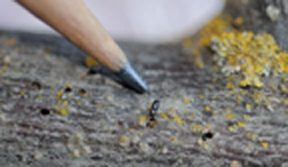
Walnut Twig Beetle and twig beetle holes on walnut branch: Kathy Keatley Garvey, UC Davis
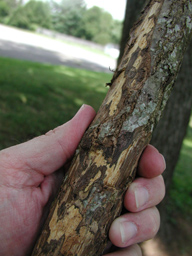
Dark staining caused by Geosmithia cankers

Leaf wilting and branch decline indicating advancing TCD infection
American Chestnut Trees Return to the Hoosier National Forest
By Teena Ligman
Once a prominent forest tree in southern Indiana, potentially blight resistant American chestnut trees have now been re-planted on the Hoosier.
The first of two areas have been planted with blight-resistant American chestnut trees on the Hoosier National Forest. Eleven Forest Service employees, three people from Purdue University, and one person from the Northern Research Station and from the Indiana Chapter of The American Chestnut Foundation (TACF), came out for the memorable day to help plant American chestnut back on the Forest.
Chris Thornton, Forest Silviculturist, led the effort for the Hoosier, saying “I think it’s a neat project. It was a lot of work, but it’s the first place in Indiana that they’ve planted chestnuts other than in research plots so we’re pretty proud to be part of that.”
Thornton worked with Jim McKenna from the Forest Service Northern Research Station’s Hardwood Tree Improvement and Regeneration Center. McKenna said that the purpose of the planting is to confirm the blight resistance of the 15/16 TACF American chestnut seedlings and to make sure that they are competitive in a forest environment.
The blight resistant American chestnut trees are the product of initially hybridizing American chestnut with Chinese chestnut and then crossing those seedlings back to American chestnut for 3 generations. Genetically the trees are then 15/16th American chestnut and 1/16th Chinese chestnut. The only trait TACF tries to retain from the Chinese is natural blight resistance; otherwise, the trees look like pure Americans.
The first planting consists of 606 trees.
* 322 Fully resistant American chestnuts from TACF in Virginia
* 60 Indiana 15/16 American chestnuts from IN-TACF Indiana
* 66 Pure American chestnut trees – Indiana
* 50 Chinese chestnut trees – Purdue
* 108 Native oaks around the edges (black, scarlet, and northern red) – Indiana Division of Forestry (IDNR), Vallonia Nursery. All of the chestnut stock for this trial was grown at the IDNR Vallonia Nursery.
The Chinese chestnuts function as “controls” to compare their blight resistance with the resistance of the fully-resistant American chestnuts. Likewise, the pure American chestnut will function as a fully susceptible control, that is, it should have no resistance. The oak trees border the chestnut planting and can provide species competition data. According to Thornton the Chinese and pure American chestnuts will be removed before flowering to prevent cross-pollination with the blight resistant seedling or local seed sources.
Thornton said these trees will be given every opportunity to do well. They were planted in a fenced enclosure to keep out deer and minimize browse and damage from wildlife. They will have herbicides applied as needed to control weeds and undesirable competition.
The fenced enclosure was built with help from fire crews from the Ottawa and White Mountain, Hoosier employees, Northern Research Station, Purdue University, and IN-TACF people. Thornton explained the area was part of a group selection sale so it was heavily covered with tops from the timber sale which were bucked up into smaller pieces so the planters could move through the site and plant the trees on a pre-determined 8-foot square grid pattern. Everyone who helped agreed it was a hard job climbing around the slash and digging holes for the one-year-old seedlings which for the most part had large well developed root systems.
Ron Doyle planted the first 15/16th blight-resistant American chestnut on the Hoosier. He named it “Irvin Huckleberry” after his father who has been a long-time member of the American Chestnut Foundation. His father was very pleased to hear the trees were returning to Indiana and though he’s now in a nursing home, Ron took pictures of his name-sake tree to show his dad.
Thornton said as word of this planting has leaked out, other people in the area, especially older people who remember the chestnut trees, have been excited as well to hear that the chestnut is returning to the Forest. He said these first trees will be closely monitored. Each individual tree’s location will be determined by GPS and checked often.
Another site with similar protocols will be planted in 2012.
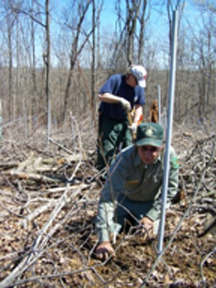
Kirk Larson and Ron Doyle plant American Chestnut trees on the Hoosier NF
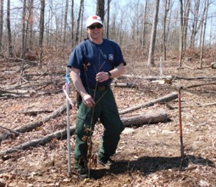
Ron Doyle with the Irvin Huckleberry tree he planted for his father
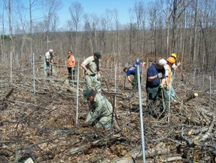
Planting crew of Hoosier employees hard at work planting trees amongst the downed tops
To view the original article follow this link
Have questions about tree planting? This series of publications can be viewed or downloaded free of charge. Planting and Care of Fine Hardwood Seedlings
Van Eck Scholarships available for graduate research with the HTIRC.
Ask the HTIRC: email Lenny Farlee with your tree planting and forest management questions and we’ll help you find the answers.
